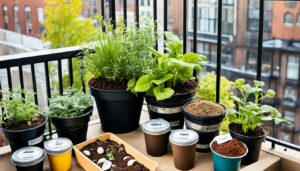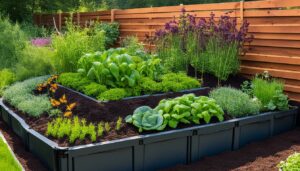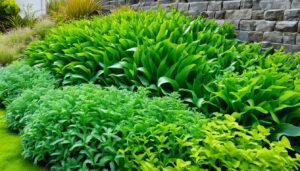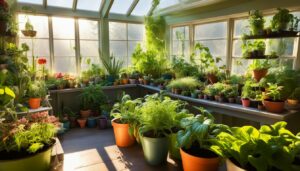It’s a compelling thought that the stretches of green behind our homes could be more than just eye-pleasing landscapes, but a testament to our commitment to the planet. The concept of sustainable garden design is transforming traditional views on landscaping, marrying aesthetics with eco-responsibility. Integrating green eco-friendly landscaping ideas aren’t just about planting a tree or two; it’s about cultivating a space that enthusiastically embraces green gardening practices, fostering vibrant, green outdoor spaces that thrive in harmony with nature.
Imagine stepping outside to a garden designed not only for its beauty but for its beneficial impact on the environment around you. With carefully considered eco-friendly garden design ideas, it’s not just about adding value to your property but adding value to the ecosystem you’re a part of. It’s about creating a biodiverse sanctuary that tells a story of sustainability and conscious living with every leaf, petal, and patch of soil. Join us as we dig into the roots of green gardening and unearth how you can play a crucial role in environmental stewardship from the comforts of your own backyard.
Key Takeaways
- Discover how sustainable garden design enhances biodiversity and reduces ecological footprints.
- Understand the economic and environmental benefits of adopting eco-friendly landscaping techniques.
- Learn to translate green gardening practices into beautifying and nurturing natural living spaces.
- Explore even the simplest eco-friendly garden design ideas to start making a significant impact.
- Recognize the potential of your outdoor area to become a champion of sustainability that supports local wildlife.
Understanding Sustainable Garden Design Principles
As we delve into the realm of environmental conscious garden planning, it becomes apparent that the transformative power of sustainable landscaping solutions extends well beyond the confines of our backyards. This integrative approach to green living garden design harmonizes the needs of nature with our desire for beautiful outdoor spaces, all the while ensuring every plant and path contributes positively to the world around us.
Benefits of an Eco-Friendly Approach to Gardening
Embracing sustainable horticulture practices is not just about producing a gleaming patch of green. It’s about crafting ecosystems that thrive on minimal intervention while yielding maximum benefits. These practices often translate into cost savings, minimize water use, and foster an environment where diverse forms of life can flourish.
Adapting to Climate Change with Sustainable Landscaping Solutions
As climate patterns shift unpredictably, the resilience of our gardens is tested. Modern sustainable landscaping solutions involve selecting plant species adaptable to a wide range of conditions and deploying innovative design techniques that account for extremes in weather—be it excess rain or drought conditions.
The Role of Soil Health in Green Gardening Practices
At the foundation of any thriving garden is healthy soil, a living tapestry teeming with microorganisms that support robust plant growth. Enriching soil with organic compost and mulch not only nurtures plant life but also ensures the soil’s vitality is preserved for future planting endeavors.
| Eco-Friendly Feature | Benefits | Implementation in Garden Design |
|---|---|---|
| Native Plant Varieties | Enhances biodiversity, requires less maintenance | Research local species, integrate into planting strategy |
| Organic Soil Amendments | Promotes soil health, supports micro-ecosystems | Use compost and mulch, avoid chemical fertilizers |
| Water Conservation Methods | Saves water, reduces utility bills | Install drip irrigation, collect rainwater, employ xeriscaping |
| Renewable Energy Sources | Reduces fossil fuel reliance, lowers carbon footprint | Use solar-powered lighting, manual or electric tools |
By adhering to these environmental conscious garden planning principles, gardeners contribute to a holistic vision of sustainability that reaches beyond the aesthetic value of their outdoor spaces, fostering a deeper connection with the natural world.
Essential Elements of Environmentally Conscious Garden Planning
When we delve into the nuances of environmentally conscious garden planning, several key factors stand out. Notably, the incorporation of native plants and the application of smart irrigation techniques are pivotal. Moreover, attention to reducing energy usage further cements a sustainable approach. Let’s explore the measures that encapsulate eco-friendly landscaping and sustainable landscaping solutions.
The Importance of Native Plants and Resilient Plant Varieties
Native plants play a critical role in crafting an eco-friendly landscape. They are inherently more adapted to the local climate and soil conditions, reducing the need for supplementary care such as watering, fertilizers, and pesticides. Furthermore, they provide a natural habitat for local wildlife, supporting biodiversity within the garden ecosystem. Embracing resilient plant varieties ensures that your garden can thrive, even in the face of climate challenges.
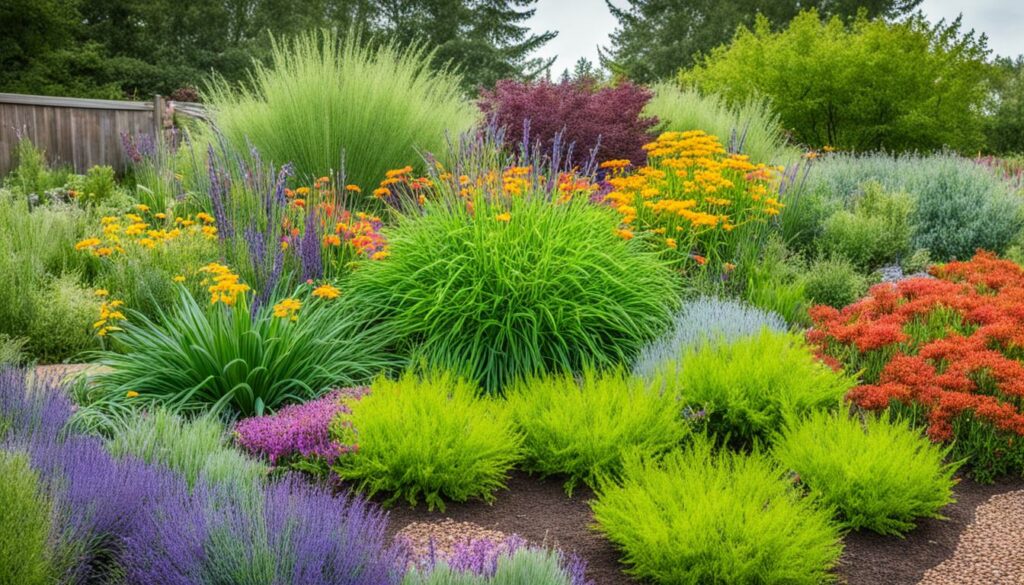
Conserving Water with Smart Irrigation Techniques
Water conservation is a pillar of sustainable landscaping solutions. Smart irrigation systems, including drip irrigation and soaker hoses, deliver water directly to the root zone, reducing waste. Additionally, the use of rain barrels to collect and store rainwater for later use exemplifies responsible water management. Integrating water-conserving strategies into your garden not only saves a precious resource but also echoes a deeper commitment to environmental stewardship.
Reducing Energy Use and Carbon Footprint in Garden Design
Minimizing energy consumption is yet another cornerstone of environmentally conscious garden planning. Opting for manual or electric garden tools over gasoline-powered equipment can make a significant dent in your garden’s carbon footprint. Likewise, reducing lawn space and incorporating solar-powered lighting are actionable steps towards an energy-efficient and eco-friendly landscape.
Through a concerted effort towards these principles, gardeners can not only create beautiful outdoor spaces but also contribute positively to the wellbeing of the environment. It’s a harmonious blend of aesthetics and ethics—ensuring that every plant, pathway, and practice reflects a deep-rooted commitment to our planet’s future.
Designing a Garden with Sustainable Horticulture Practices
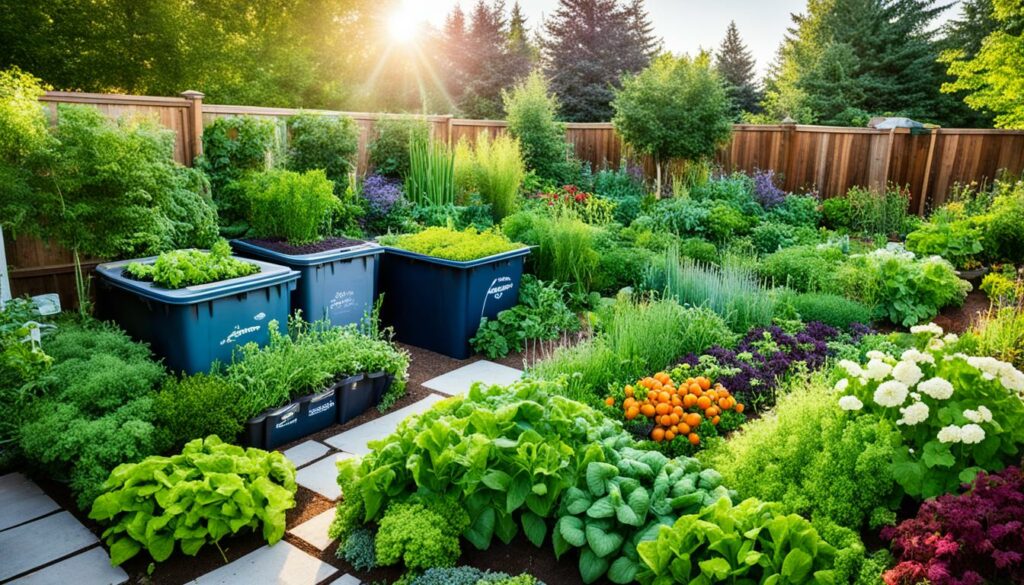
Embracing sustainable horticulture practices is essential for cultivating a thriving garden that’s in harmony with the environment. Beyond the aesthetic charm, a sustainable garden design aims to support the local ecosystem, promoting a symbiotic relationship between flora and fauna. Let’s delve into the core practices and considerations for creating striking eco-friendly garden design ideas that bolster sustainability.
| Eco-Friendly Technique | Benefits | Implementation Tips |
|---|---|---|
| Perennial Selection | Reduced soil disturbance and less frequent replacement | Choose species native to your region for better adaptation |
| Seed Harvesting | Saves money and promotes genetic diversity | Tag your best plants for seed collection and storage for next season |
| Drought-Resistant Varieties | Lower water requirements and higher survival rates in dry conditions | Research plants that naturally thrive in arid climates |
| Eco-Friendly Lawn Care | Minimizes water and energy usage | Use mulching mowers and natural lawn treatments |
| Composting Garden Waste | Enriches soil and reduces landfill contributions | Set up a composting area or bin to recycle organic waste |
Sustainable gardening also involves incorporating organic gardening methods. Avoid synthetic fertilizers and pesticides; instead, opt for natural compost and organic pest control solutions, welcoming a balanced ecosystem. A rich tapestry of insect and plant life is not only beneficial for your garden’s health but also contributes to larger environmental conservation efforts.
- Organic Compost: Utilize kitchen scraps and garden waste to create nutrient-rich compost that nourishes your plants without chemical additives.
- Natural Pest Control: Employ beneficial insects, companion planting, and barriers to manage pests in a way that supports biodiversity.
- Plant Diversity: Cultivate a diverse array of plants to create a resilient environment where pests and diseases are less likely to spread.
Green Living Garden Design: Building Biodiversity and Ecosystem Health
Among the waves of green initiatives, the concepts of sustainable landscaping solutions and eco-conscious garden design are fostering a new, environmentally friendly ideology in our backyards. These green living garden designs are more than visual artistry; they are powerful tools for enhancing biodiversity and fortifying ecosystem health.
Attracting Pollinators with Nectar-Rich Plants
Pollinators like bees, butterflies, and hummingbirds play an indispensable role in the health of our planet, and their attraction to our gardens is essential for a flourishing ecosystem. By incorporating a range of nectar-rich flowers, we can create a vivid tapestry that serves both aesthetic allure and as a critical lifeline for these industrious species. From vibrant coneflowers to fragrant lavender, each plant selection is a strategic step toward a thriving, biodiverse environment.
Integrating Companion Planting and Permaculture Concepts
Companion planting represents an ancient practice that modern eco-conscious enthusiasts are re-embracing. It involves strategically placing plants together that can benefit one another, reducing the need for chemical interventions. Pairing this with permaculture principles, which aim at creating sustainable and self-sufficient ecosystems, our gardens become a bastion for natural pest control and ecological balance that nurtures both the land and its inhabitants.
Supporting Local Wildlife Through Habitat Creation
In an effort to further support the web of life within our green spaces, green living garden design also includes creating and maintaining habitats for local wildlife. By allotting parts of our gardens to remain untamed or by installing structures like birdhouses and pollinator hotels, we provide refuge and breeding grounds for a variety of species, leading to a dynamic and self-regulating ecosystem right in our own backyards.
A paradigm shift toward green living garden design with its roots in sustainable landscaping solutions and eco-conscious garden design is indeed a progressive leap forward in cultivating vibrant, healthy, and resilient environments.
Implementing Eco-Conscious Garden Design Ideas
As we delve into the practical application of eco-conscious garden design, it becomes apparent that the choices we make in our gardens reflect our commitment to sustainability. To cultivate a space that requires minimal resources while providing maximum beauty and environmental benefits, several key strategies can be employed. Each method contributes not only to the design aspect but also fortifies the very essence of what it means to create a sustainable garden design.
Selection of Drought-Resistant and Low-Maintenance Plants
Selecting plant species that are both drought-resistant and low-maintenance is vital in developing an eco-friendly garden design. Plants like succulents, lavender, and sedum not only conserve water but also require less upkeep, proving to be a prudent choice for the eco-minded gardener.
Utilizing Recycled Materials and Compost in Garden Construction
Utilizing recycled materials such as repurposed wood for planters and incorporating rich homemade compost enhances soil quality and reduces waste. These practices not only reduce our carbon footprint but also amplify the effectiveness of a green garden.
Alternatives to Chemical Pesticides and Synthetic Fertilizers
Turning to organic solutions instead of chemical-based products is an integral part of any eco-friendly garden design idea. By employing natural pest deterrents and organic fertilizers, we not only safeguard the environment but also protect the health of the garden’s ecosystem.
| Pest Control Method | Benefits | Application |
|---|---|---|
| Companion Planting | Enhances biodiversity and natural pest management | Planting basil near tomatoes to repel flies and mosquitoes |
| Neem Oil | Organic, multi-purpose pest control | Diluted with water as a foliar spray |
| Ladybugs | Natural predators for common pests like aphids | Releasing them in the evening around infested plants |
Conclusion
In our journey through sustainable garden design, we’ve explored the essential elements needed to create green outdoor spaces that are both visually striking and environmentally responsible. Embracing such eco-friendly landscaping practices is far from a passing trend; it is an enduring lifestyle choice that requires commitment and love for our Earth. It integrates seamlessly into our routines, homes, and communities, carrying the potential to inspire change and a greater good.
Embracing Sustainable Garden Design as a Lifestyle Choice
As we forge ahead, we recognize that sustainable garden design is not merely about the physical arrangements of plants and paths but rather a reflection of the values we hold dear regarding planetary stewardship. The choices made in our gardens—whether it’s selecting the right companion plants or conserving water—echo a philosophy where green gardening practices resonate deeply within our way of living.
Continuing Education and Community Involvement in Eco-Friendly Landscaping
The path toward a greener future is paved with continuous education and active participation in eco-friendly initiatives. By immersing ourselves in the cycle of learning and sharing our insights on eco-conscious garden design, we contribute to a collective movement that advances environmental conservation. Engaging with others in our localities, nurturing spaces that celebrate biodiversity, and adhering to sustainable practices all play pivotal roles in crafting a healthier planet for all. The harmonious integration of these principles amplifies not only the beauty of nature but also the potential for a vibrant and sustainable environment that endures for generations to come.



